A popular classic spring dessert, Strawberry Mochi (Ichigo Daifuku) is soft and springy shiratamako mochi stuffed with a fresh whole strawberry and sweet red bean paste. Make my recipe at home and indulge in this beautiful and delicious Japanese delicacy!
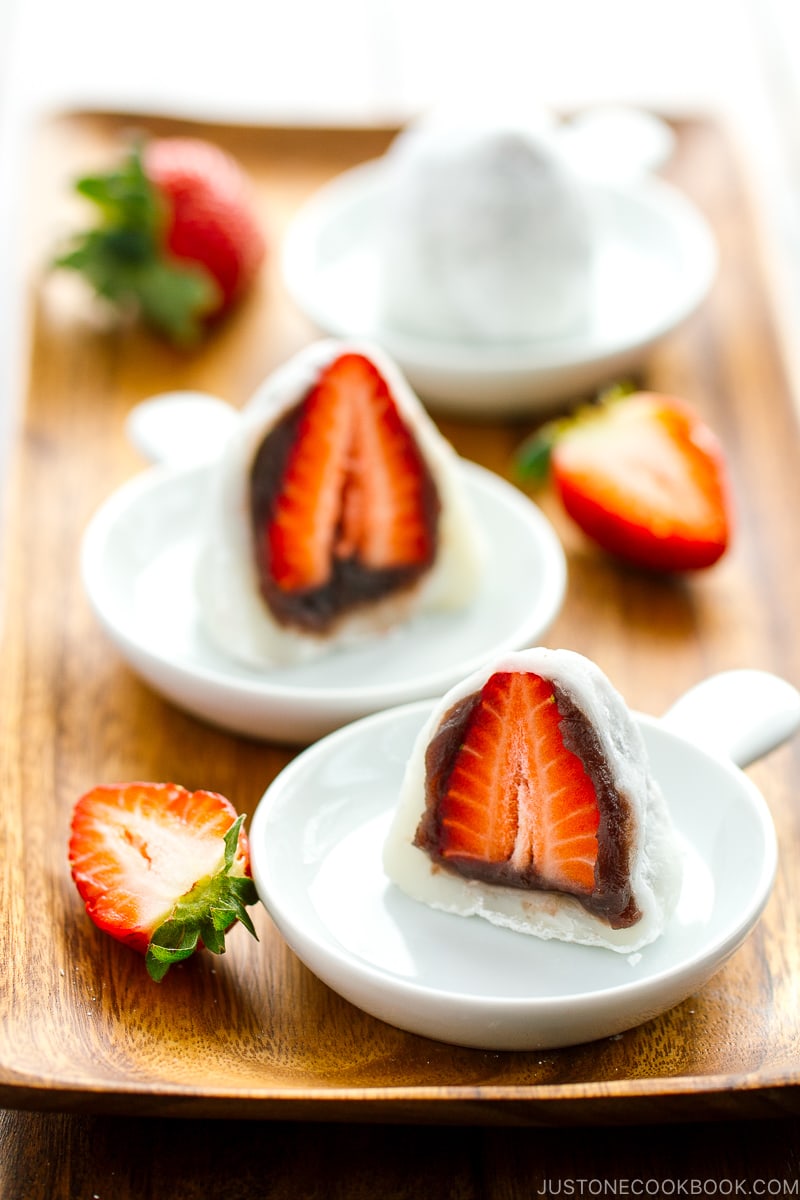
During the springtime, Japanese confectionery shops sell a seasonal daifuku, Strawberry Mochi (Ichigo Daifuku いちご大福), with a whole strawberry as the filling. The taste and texture combination of fresh, soft mochi, sweet red bean paste, and a juicy, tart strawberry is a match made in heaven.
If you love juicy strawberries, sweet red bean paste, and chewy mochi, you will love this Japanese dessert! I’ll guide you through the process of make it with step-by-step photos in my Strawberry Mochi recipe.
Table of Contents
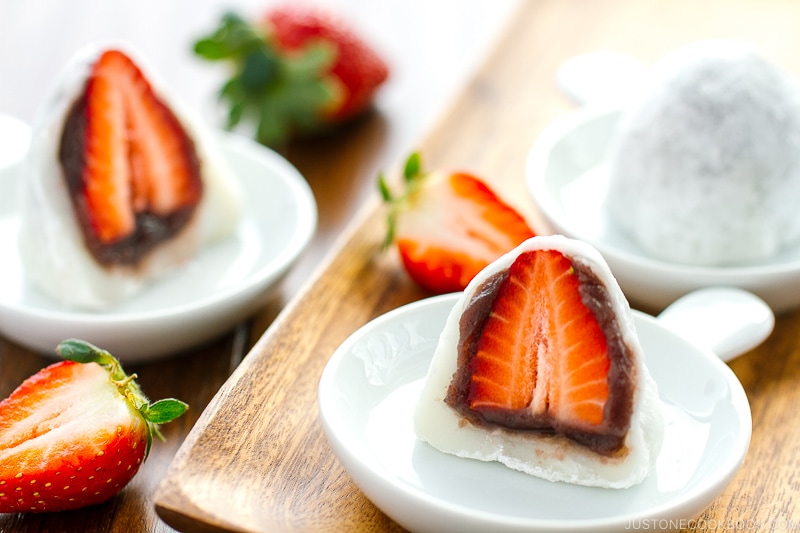
What is Strawberry Mochi?
Strawberry mochi (or ichigo daifuku) is a modern rendition of a traditional Japanese sweet called daifuku (大福). Filled only with sweet red bean paste, the original Daifuku comes with the same soft and chewy mochi exterior.
Strawberry mochi was first created in the 1980s, so it’s considered a relatively new wagashi. It’s a traditional Japanese confectionery with a modern twist.
Depending on regions and stores, some strawberry mochi have a red bean paste filling while others use white bean paste called shiroan. Some mochi come with whipped cream and strawberry inside instead of red bean or white bean paste.
These vegan, seasonal treats use fresh strawberries, so they are only offered during the strawberry season in Japan, which falls between winter and spring.
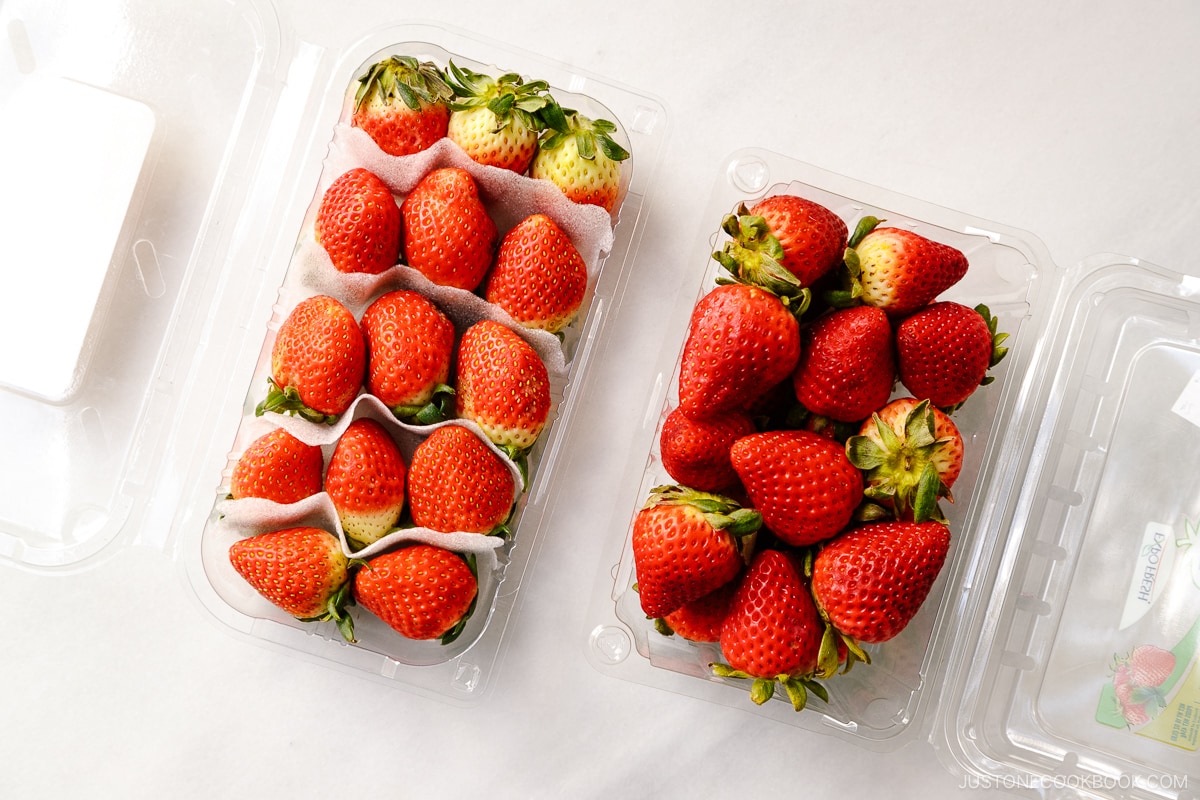
Ingredients You’ll Need
- fresh strawberries – go with organic and smaller-sized strawberries
- sweet red bean paste (anko) – I used store-bought koshian (smooth red bean paste); you can make my recipe for homemade Anko or Pressure Cooker Anko)
- shiratamako (glutinous rice flour/sweet rice flour), sugar, and water – for the outer mochi shell; shiratamako has a refined flavor and springy texture; please do not substitute mochiko
- potato starch or cornstarch – for dusting
How To Make Strawberry Mochi
Here’s a quick overview of how to make strawberry daifuku mochi from scratch, but you can find my detailed step-by-step instructions in the recipe card below:
- Prepare the strawberry filling. Wrap each cleaned and dried strawberry with an anko (red bean paste) ball.
- Make the mochi. Whisk the shiratamako with sugar and water, and microwave the mixture in a microwave-safe bowl. Make sure there are no lumps. Divide the mochi into equal portions.
- Shape the daifuku. Cover your hands with some potato starch or cornstarch. Flatten and expand each mochi into a round or square. Begin shaping the daifuku by placing the anko-covered strawberry on top and in the center of the mochi, with the tip pointing down. Now you are done. Serve and enjoy at room temperature.
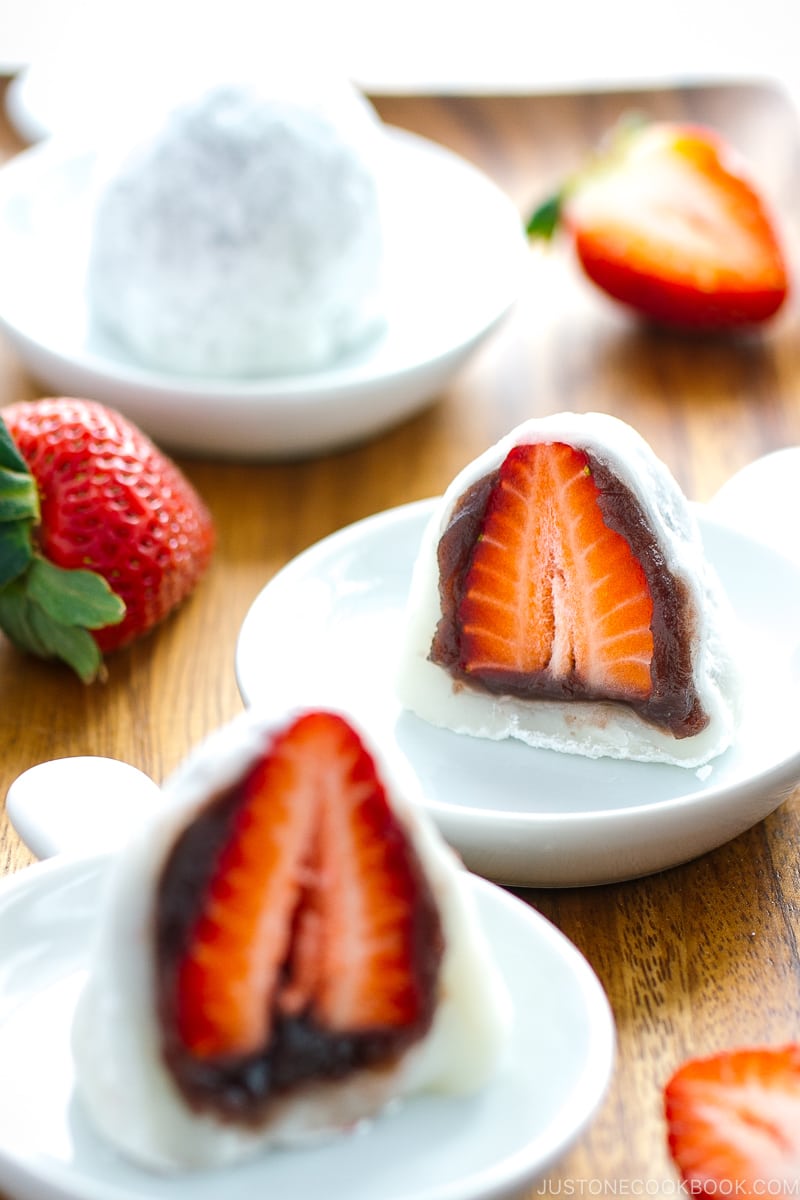
3 Tips for Making the Best Strawberry Daifuku
Making daifuku is very much a craft. The process can be fun and meditative, but don’t rush it. Here are a few simple tips to follow for the best-looking mochi:
- Wash your hands and dry completely each time you wrap a strawberry with anko.
- Be careful not to stretch the mochi dough too thin. When working with mochi dough, be careful not to stretch it too thin to prevent tearing.
- Coat your fingers with enough potato starch or cornstarch when wrapping the strawberry anko with the mochi skin.
Storage Tips
Keep the leftovers in an airtight container and store it at room temperature. Do not put it in the refrigerator as the cold temperature makes the mochi hard. Consume within 2 days.
Perfect Spring Dessert To Make with Kids
Sweet, elegant, and delicate, strawberry mochi is another delicious way to celebrate the season.
My daughter loves helping me wrap the sticky, elastic mochi around the berries when I make daifuku for them. It’s like working with edible play dough for her. Although her shaping skills still need improvement, she usually thinks her daifuku are the prettiest and tastiest. What can I say?
If you make my Strawberry Mochi recipe, I’d love to hear how it turns out in the comments below! You can also send me a picture on Instagram. Seeing your creations makes me happy!
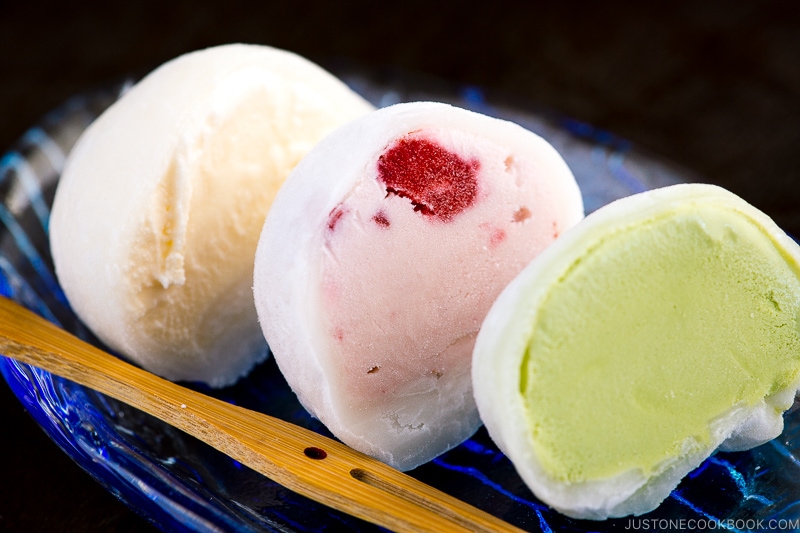
Other Mochi Desserts You’ll Enjoy
- Mochi Ice Cream
- Classic Daifuku
- Green Tea Mochi
- How to Make Mochi with a Stand Mixer
- Butter Mochi
- Shiratama Dango in Anmitsu and Oshiruko
Wish to learn more about Japanese cooking? Sign up for our free newsletter to receive cooking tips & recipe updates! And stay in touch with me on Facebook, Pinterest, YouTube, and Instagram.
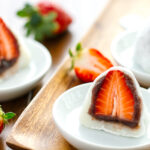
Strawberry Mochi (Ichigo Daifuku)
Ingredients
- 6 strawberries (smaller ones are easier to work with)
- 5.3 oz sweet red bean paste (anko) (I used store-bought koshian; you can make my recipe for homemade Anko or Pressure Cooker Anko)
- potato starch or cornstarch (for dusting)
For the Mochi Using a 100 g Shiratamako Package
- ¾ cup shiratamako (glutinous rice flour/sweet rice flour)
- 1½ Tbsp sugar
- 150 ml water (⅔ cup minus 2 tsp)
For the Mochi Using a 120 g Shiratamako Package
- 120 g shiratamako (glutinous rice flour/sweet rice flour) (1 cup minus 2 Tbsp)
- 2 Tbsp sugar
- ¾ cup water
Instructions
- Before You Start: If you want to make more than 6 pieces, I highly recommend you to work in batches. If you do not have a microwave, please see Notes for other options to cook the shiratamako.
To Prepare the Strawberries
- Rinse, dry, and hull 6 strawberries. Divide 5.3 oz sweet red bean paste (anko) and roll into 6 same-size balls. Anko gets sticky on your hands, so wash and completely dry your hands each time you make a ball.

- Wrap each strawberry with the anko from one ball. Leave the tip of the strawberry uncovered. Wash your hands and dry completely each time you wrap a strawberry with anko.

To Cook the Shiratamako
- In a medium microwave-safe glass bowl, mix the shiratamako and sugar with a whisk. For a 100 g bag, mix 100 g or ¾ cup shiratamako (glutinous rice flour/sweet rice flour) and 1½ Tbsp sugar. For a 120 g bag, mix 120 g shiratamako (glutinous rice flour/sweet rice flour) (or 1 cup minus 2 Tbsp) and 2 Tbsp sugar.
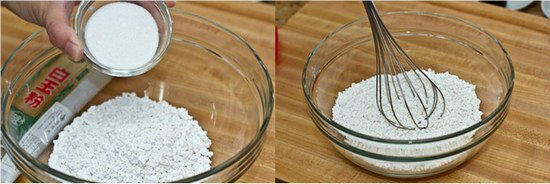
- Using a silicone spatula, slowly add the water in 3 parts—a total of 150 ml water (⅔ cup minus 2 tsp) for the 100 g shiratamako bag and ¾ cup water for the 120 g bag. Stir until the mixture has reached a thick consistency. Cover loosely with plastic wrap.

- First, microwave the mixture for 1 minute (for 1100W microwave). Mix well with a wet silicone spatula. The mixture is still whitish and floury.

- For a second time, microwave 1 minute again, and mix well with the wet silicone spatula. Now it starts to resemble mochi, but there are still some floury parts.

- For the last time, microwave only 30 seconds. Now the mochi mixture should look translucent.
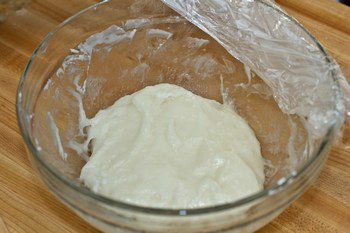
- Sift the potato starch or cornstarch on the tray and put the mochi on top.
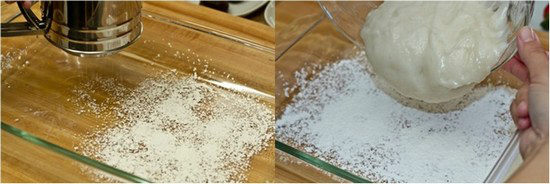
- With the silicone spatula or a kitchen scraper, fold the mochi in half one time so it won’t be as sticky. Then, divide into 6 equal pieces.
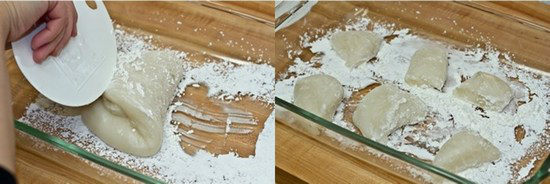
To Shape the Strawberry Daifuku
- Put some potato starch or cornstarch on your hands. Flatten and expand each mochi into a 3-inch (7.6-cm) round or square. Then, put the anko-covered strawberry on top of it, with the tip pointing down.
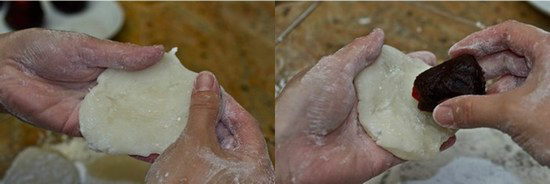
- Start gathering the mochi edges to cover the strawberry from all sides. Use your thumb to hold the gathered mochi on top.

- When all edges of the mochi meet at the top, twist and close the seam. Hold the mochi with both hands and form into a nice round shape. Place the daifuku seam side down on a plate with the strawberry tip pointing up. Repeat the process for the remaining mochi.

To Serve
- Serve at room temperature.

To Store
- Keep the leftovers in an airtight container and store at room temperature. Do not put in the refrigerator as the cold temperature makes the mochi hard. Consume within 2 days.
Notes
- Rice cooker: Put the ingredients in the bowl of the rice cooker and mix well. Cook for 10-12 minutes or until the mixture is translucent. Mix with silicon spatula at least 2 times during cooking.
- Steamer: Put the ingredients in a heatproof bowl that fits inside your steamer. Mix well and cover with a thin kitchen towel or heatproof plate. Cook for 10-12 minutes or until the mixture is translucent. Mix with silicon spatula at least 2 times during cooking.
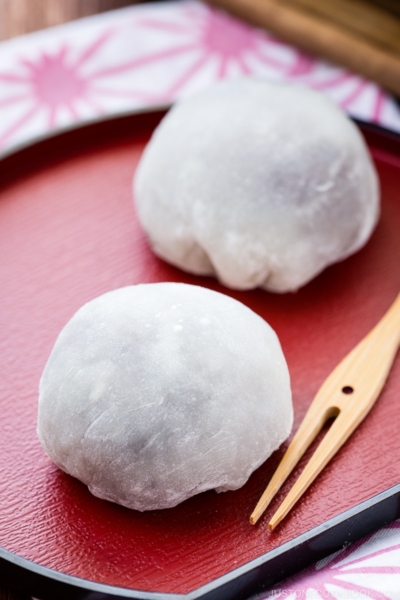
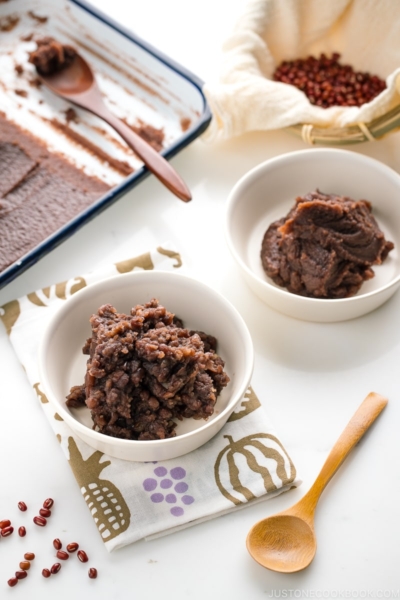
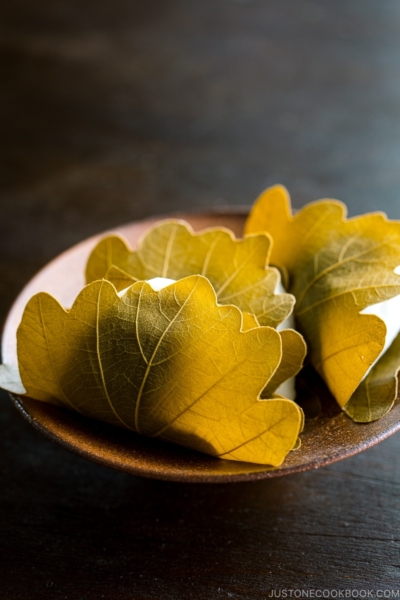
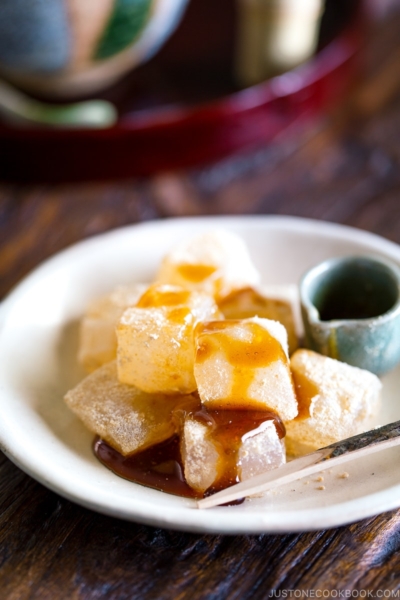





Wow, to think that the need for an Ichigo Daifuku recipe brought me here…This blog is definitely going to be one of my favorites!*__* I’m looking forward to try out more of your recipes!^0^ Greetings from Switzerland:D
Hi Mika! Welcome to Just One Cookbook! So glad to hear you enjoy my blog. Thank you so much for your kind comment! 🙂
I bought the ingredients for this yesterday and I’m going to make it sometime this week with my boyfriend! Im going to make some regular and some with the strawberries in them, but i was wondering if the mochi can be refrigerated? I noticed you said it should be served at room temp. but I’ve always preferred my mochi a bit cold, would this ruin the mochi if i put in the refrigerated for a couple hours before eating?
Hi Kristen! I hope you enjoy this recipe! You can keep in the refrigerator (and eat it cold too!). When mochi is cold, it gets hard and lose that sticky texture, which is why I recommend to eat it at the room temperature. Hope this helps! Enjoy!
Thanks so much for this recipe, Nami! I finally got around to making it today, and I am in love with the combination of flavors. It goes very well with matcha. I would have posted a picture to your Facebook page, but I think I need more practice before they look pretty enough haha.
I hope you post more confectionary in the future! Love your recipes,
Kaley
Hi Kaley! I’m so glad you liked it. Yeah to make it “pretty”, you may need to practice a little bit. My pictures are not my first time try, you know… 😉 And to make sure the strawberry cut through nicely, I had to open several. =P
Can i ask if its possible to do this without a microwave???
What is the next best thing to use other than a microwave???
Hi Jay! So sorry for my late response. Yes, you can make this without microwave. After #4, steam for 15 minutes (don’t use plastic wrap, you can cover with a thin kitchen towel). Hope this helps!
Thanks… 😀 this should help me a lot… 🙂
also you can use ice cream as a filling right???
i’m trying to experiment as soon as i can make this… 🙂
Hi Jay! I’ve seen it before…but I’m so clumsy that mine will never look nice! Hope you make delicious one and share with me on facebook fan page! 🙂
Hi Nami!
Greetings again from Uruguay!
I just finished my first ichigo daifuku! Very nice recipe! Will need some practice in making the balls without burning myself… 🙂
I have a question. How do you storage them? In the fridge? Inside a tight container with cornstarch so they don stick together? How long they can be in room temperature?
Thanks again!
Hi Paola! I’m so happy you liked the recipe. You can wait a little bit longer before working with hot mochi. 🙂 But I know I’m inpatient and want to work on it as soon as it’s ready.
To store, you can keep in cool place but has to be eaten by the following day (otherwise, strawberry start to give too much moisture inside mochi. If you live in warm place, try to wrap the container with towel etc and keep in the fridge (if it’s too cold, mochi will be harden). Hope this helps!
Thank you so much Nami!
So, if I do a regular daifuku (without the strawberry) it will last longer?
Yes! But I highly recommend to freeze (up to 2 weeks or so) it so it’ll taste fresher. 🙂
Hi your blog photos are so beautiful! just a question if i do not have microwave, how do i cook the glutinous rice?
Hi Carmen! You can steam them in a steamer (more traditional way). 🙂
Hi Nami,
how long do i have to steam it? the timing is like how u put it in the microwave?
Hi Carmen! I assume steaming takes more time than using microwave, but I’ve never tried it with steamer, so I’m not sure exact timing. Start with 5 minutes and keep checking when the mochi start to change color. It’s ready when the color change to more translucent (not white). 🙂
Hi,
Thanks for sharing all these wonderful recipes. I actually have a mochi maker (makes mochi from sweet rice). However, I have not been able how to keep the mochi soft. After only 1-2 days, it hardens. I try to cover it with ample potato starch, but this doesn’t help either. Please let me know if you have any suggestions. Perhaps I need to add something to the rice while it is being beat? Corn syrup instead of sugar?
Trinh
Hi Trinh! It’s very common that mochi gets hard. I checked online and it is recommended to individually pack small mochi in plastic wrap and put it in airtight bag/container and ‘freeze’ it to keep it fresh. Hope that helps. 🙂
Thank you!
hi , can i steam the shiratamako mixture ?
Hi Kit Wai! Yes, you can. 🙂
Hey nami this recipe looks absolutely nice. I have some questions to ask,is it ok if i change the flour with mochiko instead of shiratamako?will the steps different?and also to microwave it in what degree celciys?thankss
Ps:sorry i’m beginner
Hi Novi! Thank you for asking! Yes you can use mochiko instead of shiratamako. I’ve never used it so you might need to read the instruction. But it should work the same as shiratamako. My microwave is 1200 watt. Hope this helps. 🙂
Thank you so much for sharing this delicious recipe for Daifuku!
Thanks Mirian! 🙂
Hello! I’ve been looking for a mochi recipe and I want to try this one. But I don’t have a microwave! Is there another way to cook the flour? Thanks!
Hi Jeanne!
You can steam instead of microwave. That’s the traditional method. Using a steamer, cook the mixture in a cloth so you can remove easily when it’s done. When mochi looks translucent, it’s ready to take it out. Hope this helps!
Hi Nami, recently I started viewing your recipes on your website I found through google, and they look delicious! I want to try this recipe but I’m not really fond of using the microwave. Is there any other alternative? Thanks a lot!!
Hi Noelle! Thank you so much for your encouraging words and compliments. Yes, you can steam instead of microwave. It gets a little tricky, but that’s the traditional method while nowadays microwave became more common method for housewives. Use your steamer – but wrap in a cloth so you can remove easily. I’m not sure how long you need to steam, but should be longer than microwave. When mochi looks clear, it’s ready to take it out. Hope this helps. 🙂
Nami san, konnichiwa! I have made this numerous times now and I LOVE the results! Thank you so so much for posting this recipe. I made your pork and shrimp wontons and love that recipe as well :). Hontou ni arigatou!
Hi Aya-san! Thank you for trying this recipe and wontons! I’m happy you like them. 🙂 Arigato for your feedback!
Hi Nami-san,
This post is awesome! Ate this strawberry daifuku in Japan called 雪莓娘 and totally fell in love with it! I am so excited to able to try making this myself!
May I know if I can use shiratamako for dusting in place of corn starch?
Thank you. 🙂
Hi Aya-san! The first time might be difficult handing with sticky mochi texture, but you will get used to it. It’s so delicious!!
Shiratamako is very coarse so it does not work for duting purpose. If you see #3 pictures carefully, you can see how big each piece of shiratamako is. Hope you can find potato starch or corn starch. 🙂
Thanks for the tutorial. The strawberry daifuku looks delicious. Do you know if there are any matcha-flavored daifuku? I have some anko and some matcha powder and was wondering if I should make strawberry daifuku with matcha or would that be strange?
Hi Emi! Nope, it is not strange at all. There are Matcha flavored Daifuku and it’s common. However, I’ve never seen Matcha Daifuku that has a strawberry in it. I think it’s great and I’d love to try it myself. 🙂